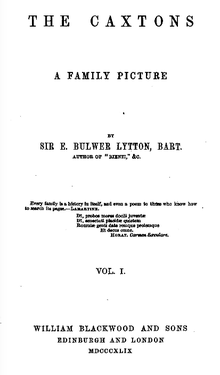
Edgar Allan Poe was an American writer, poet, editor, and literary critic who is best known for his poetry and short stories, particularly his tales of mystery and the macabre. He is widely regarded as a central figure of Romanticism in the United States, and of American literature. He was one of the country's earliest practitioners of the short story, and is considered the inventor of the detective fiction genre, as well as a significant contributor to the emerging genre of science fiction. He is the first well-known American writer to earn a living through writing alone, resulting in a financially difficult life and career.

Edward George Earle Lytton Bulwer-Lytton, 1st Baron Lytton, PC was an English writer and politician. He served as a Whig member of Parliament from 1831 to 1841 and a Conservative from 1851 to 1866. He was Secretary of State for the Colonies from June 1858 to June 1859, choosing Richard Clement Moody as founder of British Columbia. He declined the Crown of Greece in 1862 after King Otto abdicated. He was created Baron Lytton of Knebworth in 1866.
This article contains information about the literary events and publications of 1846.
This article contains information about the literary events and publications of 1841.

The Life and Opinions of Tristram Shandy, Gentleman, also known as Tristram Shandy, is a novel by Laurence Sterne, inspired by Don Quixote. It was published in nine volumes, the first two appearing in 1759, and seven others following over the next seven years. It purports to be a biography of the eponymous character. Its style is marked by digression, double entendre, and graphic devices. The first edition was printed by Ann Ward on Coney Street, York.

The Narrative of Arthur Gordon Pym of Nantucket (1838) is the only complete novel written by American writer Edgar Allan Poe. The work relates the tale of the young Arthur Gordon Pym, who stows away aboard a whaling ship called the Grampus. Various adventures and misadventures befall Pym, including shipwreck, mutiny, and cannibalism, before he is saved by the crew of the Jane Guy. Aboard this vessel, Pym and a sailor named Dirk Peters continue their adventures farther south. Docking on land, they encounter hostile black-skinned natives before escaping back to the ocean. The novel ends abruptly as Pym and Peters continue toward the South Pole.

The Coming Race is a novel by Edward Bulwer-Lytton, published anonymously in 1871. It has also been published as Vril, the Power of the Coming Race.
Lothario is a male given name that came to suggest an unscrupulous seducer of women, based upon a character in The Fair Penitent, a 1703 tragedy by Nicholas Rowe. In Rowe's play, Lothario is a libertine who seduces and betrays Calista; and his success is the source for the proverbial nature of the name in the subsequent English culture. It was first mentioned in this sense in 1756 in The World, the 18th century London weekly newspaper, No. 202. Samuel Richardson used “haughty, gallant, gay Lothario” as the model for the self-indulgent Robert Lovelace in his novel Clarissa (1748), and Calista suggested the character of Clarissa Harlowe. Edward Bulwer-Lytton used the name allusively in his 1849 novel The Caxtons. Anthony Trollope in Barchester Towers (1857) wrote of "the elegant fluency of a practised Lothario".

"It was a dark and stormy night" is an often-mocked and parodied phrase considered to represent "the archetypal example of a florid, melodramatic style of fiction writing", also known as purple prose.
The lost world is a subgenre of the fantasy or science fiction genres that involves the discovery of an unknown Earth civilization. It began as a subgenre of the late-Victorian adventure romance and remains popular into the 21st century.
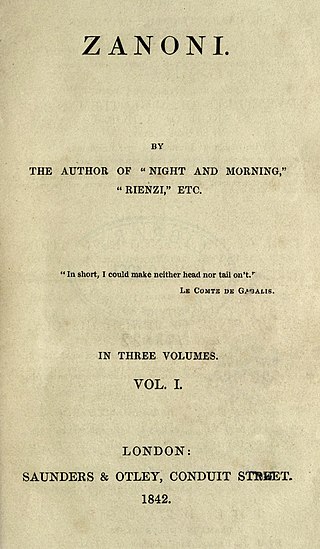
Zanoni is an 1842 novel by Edward Bulwer-Lytton, a story of love and occult aspiration. By way of introduction, the author confesses: "... It so chanced that some years ago, in my younger days, whether of authorship or life, I felt the desire to make myself acquainted with the true origins and tenets of the singular sect known by the name of Rosicrucians." A manuscript came into his hands written in the most unintelligible cipher, a manuscript which through the author's own interpretation became Zanoni.
Catherine: A Story was the first full-length work of fiction produced by William Makepeace Thackeray. It first appeared in serialized instalments in Fraser's Magazine between May 1839 and February 1840, credited to "Ikey Solomons, Esq. Junior". Thackeray's original intention in writing it was to criticize the Newgate school of crime fiction, exemplified by Bulwer-Lytton and Harrison Ainsworth, whose works Thackeray felt glorified criminals. Thackeray even included Dickens in this criticism for his portrayal of the good-hearted streetwalker Nancy and the charming pickpocket, the Artful Dodger, in Oliver Twist.

Edgar Allan Poe has appeared in popular culture as a character in books, comics, film, and other media. Besides his works, the legend of Poe himself has fascinated people for generations. His appearances in popular culture often envision him as a sort of "mad genius" or "tormented artist", exploiting his personal struggles. Many depictions of Poe interweave elements of his life with his works, in part due to Poe's frequent use of first-person narrators, suggesting an erroneous assumption that Poe and his characters are identical.
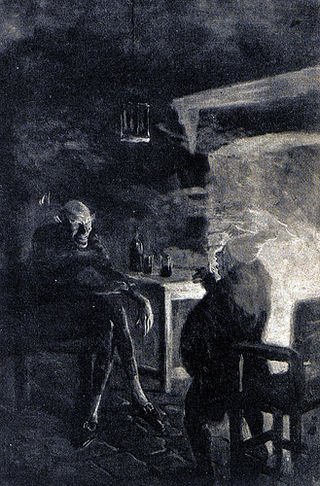
"Bon-Bon" is a comedic short story by Edgar Allan Poe, first published in December 1832 in the Philadelphia Saturday Courier. Originally called "The Bargain Lost", it follows Pierre Bon-Bon, who believes himself a profound philosopher, and his encounter with the Devil. The story's humor is based on the verbal interchange between the two, which satirizes classical philosophers such as Plato and Aristotle. The Devil reveals that he has eaten the souls of many of these philosophers.

Jules Lermina (1839–1915) was a French writer. He began his career as a journalist in 1859. He was arrested for his socialist political opinions, and received Victor Hugo's support.

Rosina Bulwer Lytton, Baroness Lytton, was an Anglo-Irish writer who published fourteen novels, a volume of essays and a volume of letters.

Rienzi vowing to obtain justice for the death of his young brother, slain in a skirmish between the Colonna and the Orsini factions is a painting by William Holman Hunt, produced in 1849 and currently in a private collection.
Richard John Warburton Lytton was an English landowner and member of the Lytton family. He was the father of Elizabeth Barbara Lytton, and the grandfather of Henry Bulwer, 1st Baron Dalling and Bulwer and Edward Bulwer-Lytton, 1st Baron Lytton.
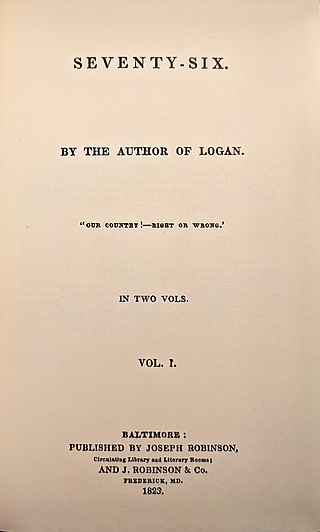
Seventy-Six is a historical fiction novel by American writer John Neal. Published in Baltimore in 1823, it is the fourth novel written about the American Revolutionary War. Historically distinguished for its pioneering use of colloquial language, Yankee dialect, battle scene realism, high characterization, stream of consciousness narrative, profanity, and depictions of sex and romance, the novel foreshadowed and influenced later American writers. The narrative prose resembles spoken American English more than any other literature of its period. It was the first work of American fiction to use the phrase son-of-a-bitch.
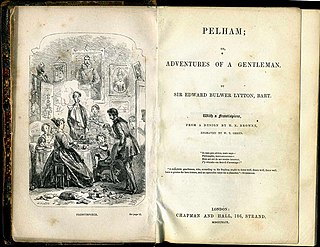
Pelham is an 1828 novel by the British writer Edward Bulwer-Lytton, originally published in three volumes. It was his breakthrough novel, launching him as one of Britain's leading authors. It is part of the tradition of silver fork novels that enjoyed great popularity in the late Regency and early Victorian eras. It follows the adventures of Henry Pelham, a young dandy, in Paris, London and the fashionable spa town of Cheltenham.
